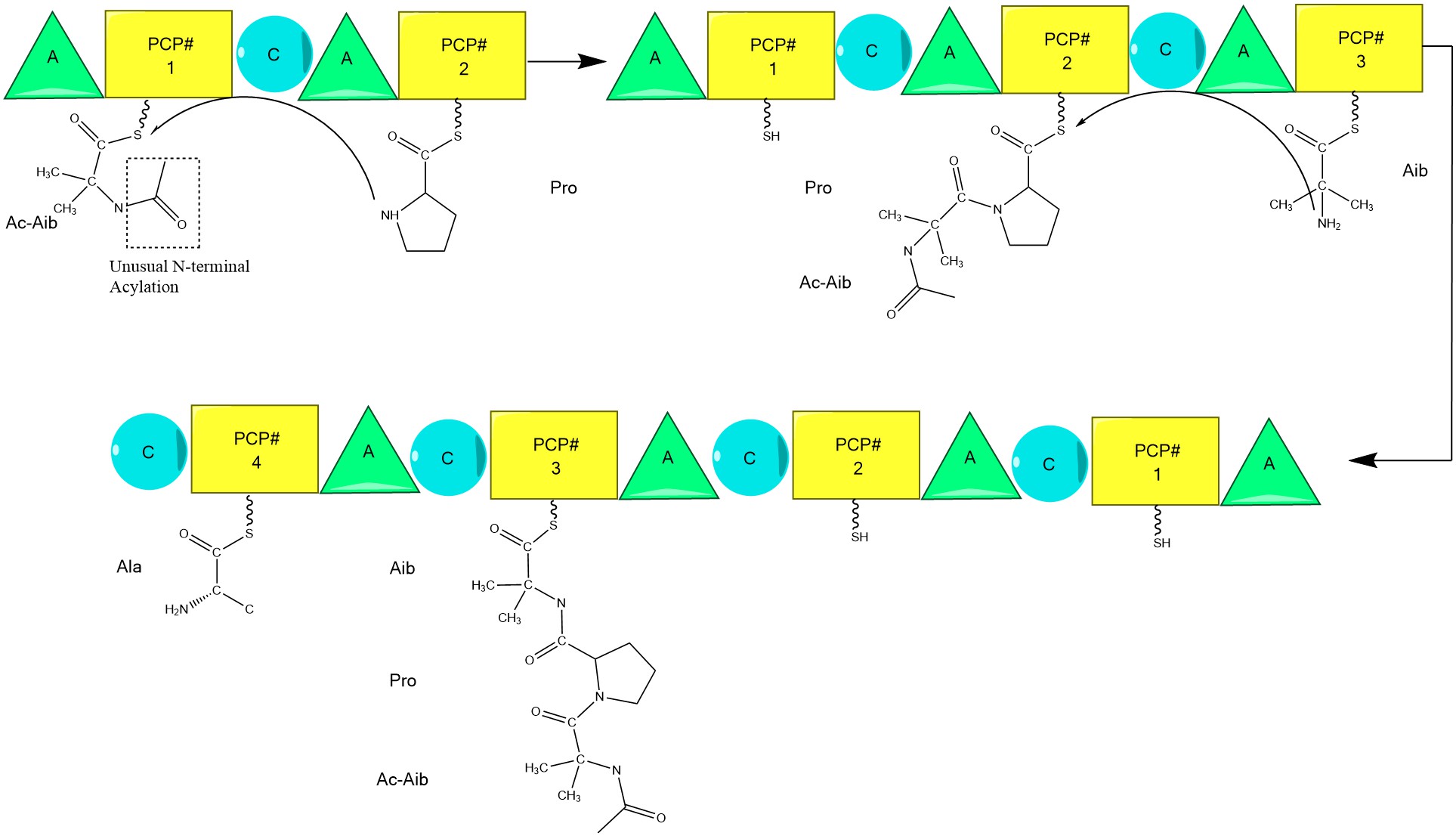alamethicin on:
[Wikipedia]
[Google]
[Amazon]
Alamethicin is a channel-forming
 Assembly is completed by the addition of phenylalaninol, an unusual amino acid-like substrate. Following addition of phenylalaninol the completed peptide chain is cleaved by the thioesterase domain, cleaving the thioester bond and leaving an alcohol.
Assembly is completed by the addition of phenylalaninol, an unusual amino acid-like substrate. Following addition of phenylalaninol the completed peptide chain is cleaved by the thioesterase domain, cleaving the thioester bond and leaving an alcohol.

Alamethicin
at the
Alamethicin
in Norine ** From "A voltage-gated ion channel model inferred from the crystal structure of alamethicin at 1.5-A resolution." * {{Non-ribosomally synthesized channels Polypeptide antibiotics Antimicrobial peptides
peptide
Peptides (, ) are short chains of amino acids linked by peptide bonds. Long chains of amino acids are called proteins. Chains of fewer than twenty amino acids are called oligopeptides, and include dipeptides, tripeptides, and tetrapeptides.
...
antibiotic, produced by the fungus ''Trichoderma viride
''Trichoderma viride'' is a fungus and a biofungicide.
It is used for seed- and soil treatment for suppression of various diseases caused by fungal pathogens.
Biology
''T. viride'' is a mold which produces spores asexually, by mitosis. I ...
''. It belongs to peptaibol peptides which contain the non-proteinogenic amino acid residue Aib (2-aminoisobutyric acid
2-Aminoisobutyric acid (also known as α-aminoisobutyric acid, AIB, α-methylalanine, or 2-methylalanine) is the non-proteinogenic amino acid with the structural formula H2N-C(CH3)2-COOH. It is rare in nature, having been only found in meteorites ...
). This residue strongly induces formation of alpha-helical structure. The peptide sequence is:
Ac-Aib-Pro-Aib-Ala-Aib-Ala-Gln-Aib-Val-Aib-Gly-Leu-Aib-Pro-Val-Aib-Aib-Glu-Gln-Phl
(Ac = acetyl, Phl = phenylalaninol, Aib = 2-Aminoisobutyric acid
2-Aminoisobutyric acid (also known as α-aminoisobutyric acid, AIB, α-methylalanine, or 2-methylalanine) is the non-proteinogenic amino acid with the structural formula H2N-C(CH3)2-COOH. It is rare in nature, having been only found in meteorites ...
)
In cell membrane
The cell membrane (also known as the plasma membrane (PM) or cytoplasmic membrane, and historically referred to as the plasmalemma) is a biological membrane that separates and protects the interior of all cells from the outside environment ( ...
s, it forms voltage
Voltage, also known as electric pressure, electric tension, or (electric) potential difference, is the difference in electric potential between two points. In a static electric field, it corresponds to the work needed per unit of charge to ...
-dependent ion
An ion () is an atom or molecule with a net electrical charge.
The charge of an electron is considered to be negative by convention and this charge is equal and opposite to the charge of a proton, which is considered to be positive by conve ...
channels by aggregation of four to six molecules.
Biosynthesis
Alamethicin biosynthesis is hypothesized to be catalyzed by alamethicin synthase, aNonribosomal peptide Nonribosomal peptides (NRP) are a class of peptide secondary metabolites, usually produced by microorganisms like bacteria and fungi. Nonribosomal peptides are also found in higher organisms, such as nudibranchs, but are thought to be made by bacter ...
synthase (NRPS) first isolated in 1975. Although there are several sequences of the alamethicin peptide accepted, evidence suggests these all follow the general NRPS mechanism with small variations at select amino acids. Beginning with the acylation
In chemistry, acylation (or alkanoylation) is the chemical reaction in which an acyl group () is added to a compound. The compound providing the acyl group is called the acylating agent.
Because they form a strong electrophile when treated with ...
of the N terminal of the first aminoisobutiric acid on the ALM synthase enzyme by Acetyl-CoA, this is followed by the sequential condensation of amino acids by each modular unit of the synthetase. Amino acids are initially adenylated by an “adenylylation
Adenylylation, more commonly known as AMPylation, is a process in which an adenosine monophosphate (AMP) molecule is covalently attached to the amino acid side chain of a protein. This covalent addition of AMP to a hydroxyl side chain of the prote ...
” (A) domain before being attached by a thioester
In organic chemistry, thioesters are organosulfur compounds with the functional group . They are analogous to carboxylate esters () with the sulfur in the thioester playing the role of the linking oxygen in the carboxylate ester, as implied by t ...
bond to an Acyl Carrier Protein
The acyl carrier protein (ACP) is a cofactor of both fatty acid and polyketide
Polyketides are a class of natural products derived from a precursor molecule consisting of a chain of alternating ketone (or reduced forms of a ketone) and methylene ...
-like Peptidyl carrier protein. The growing chain is attached to the amino acid bearing PCP by the "condensation" (C) domain, followed by another round of the same reactions by the next module.
 Assembly is completed by the addition of phenylalaninol, an unusual amino acid-like substrate. Following addition of phenylalaninol the completed peptide chain is cleaved by the thioesterase domain, cleaving the thioester bond and leaving an alcohol.
Assembly is completed by the addition of phenylalaninol, an unusual amino acid-like substrate. Following addition of phenylalaninol the completed peptide chain is cleaved by the thioesterase domain, cleaving the thioester bond and leaving an alcohol.

References
Further reading
* * Explore structures oAlamethicin
at the
protein data bank
The Protein Data Bank (PDB) is a database for the three-dimensional structural data of large biological molecules, such as proteins and nucleic acids. The data, typically obtained by X-ray crystallography, NMR spectroscopy, or, increasingly, ...
Alamethicin
in Norine ** From "A voltage-gated ion channel model inferred from the crystal structure of alamethicin at 1.5-A resolution." * {{Non-ribosomally synthesized channels Polypeptide antibiotics Antimicrobial peptides